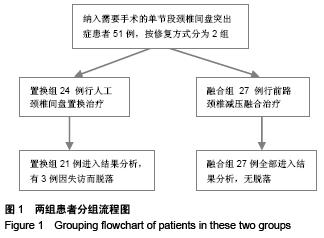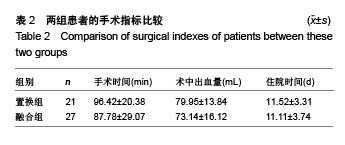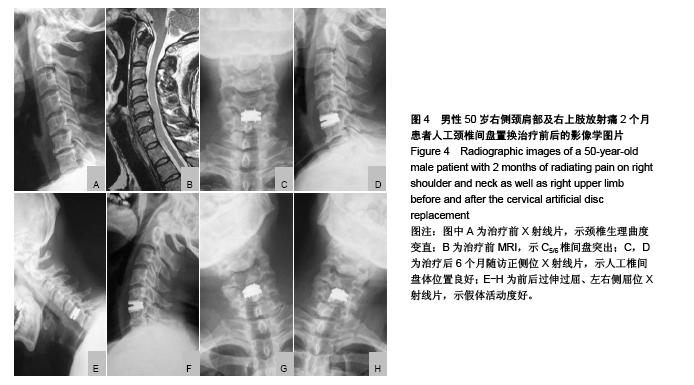| [1] Derakhshan A, Lubelski D, Steinmetz MP,et al. Global Spine J. Utility of Computed Tomography following Anterior Cervical Diskectomy and Fusion. Global Spine J. 2015;5(5):411-416.
[2] Wang JC,McDonough PW,Endow KK,et al.Increased fusion rates with cervical plating for two-level anterior cervical discectomy and fusion. Spine(Phila Pa 1976). 2000;25(1): 41-45.
[3] Matsuuloto M,Okada E,Ichihara D,et al. Anterior cervical decompression and fusion accelerates adjacent segment degeneration: comparison with asymptomatic volunteers in a ten-year magnetic resonance imaging follow up study. Spine. 2009;35(1):36-43.
[4] Boselie TF,Willems PC,van Mameren H,et al. Arthroplasty versus fusion in single-level cervical degenerative disc disease.Cochrane Database Syst Rev. 2012;12(1):9-11.
[5] 王英杰,贾连顺.人工椎间盘置换术与颈椎融合术治疗神经根型颈椎病手术疗效的比较[J].中国矫形外科杂志, 2015, 23(19): 1734-1739.
[6] 李忠海,侯树勋,吴闻文,等.单节段颈椎动态稳定器植入术对颈椎曲度和活动度的影响[J].中国骨与关节杂志, 2013, (10): 574-579.
[7] 娄纪刚,刘浩,龚全,等.单节段Prestige LP人工颈椎间盘置换术后置换节段活动度的影响因素分析[J].颈腰痛杂志, 2015, 36(1):20-24.
[8] 陈波,金格勒,杨毅,等.颈椎间盘置换与颈前路减压植骨融合治疗单节段颈椎病中期疗效的 Meta分析[J].中国脊柱脊髓杂志, 2014, 24(6): 517-525.
[9] Goffin J,Casey A,Kehr P,et al.Preliminary clinical experience with the Bryan cervical disc prosthesis. Neurosurgery. 2002; 51(3): 840-847.
[10] 任先军,王卫东,初同伟,等.人工颈椎间盘置换术后的早中期临床疗效[J].中国矫形外科杂志,2009, 17(3):164-167.
[11] Heller JG,Sasso RC,Papadopoulos SM,et al.Comparison of Bryan cervical disc arthroplasty with anterior cervical decompression and fusion:clinical and radiographic results of a randomized,controlled,clinical trial.Spine(Phila Pa 1976). 2009;34(2):101-107.
[12] Leung C,Casey AT,Goffin J,et al.Clinical significance of heterotopic ossification in cervical disc replacement:a prospective multicenter clinical trial. Neurosurgery. 2005; 57(4):759-763.
[13] Goffin J,Casey A,Kehr P,et al.Preliminary clinical experience with the Bryan cervical disc prosthesis. Neurosurgery. 2002; 51(3): 840-847.
[14] 任先军,王卫东,初同伟,等.人工颈椎间盘置换术后的早中期临床疗效[J].中国矫形外科杂志,2009, 17(3):164-167.
[15] Heller JG,Sasso RC,Papadopoulos SM,et al.Comparison of Bryan cervical disc arthroplasty with anterior cervical decompression and fusion:clinical and radiographic results of a randomized,controlled,clinical trial. Spine(Phila Pa 1976). 2009;34(2):101-107.
[16] 蓝旭,许建中,刘雪梅,等. Bryan人工颈椎间盘置换术后疗效评价及并发症分析[J].中国骨伤, 2013, 26(3): 182-185.
[17] 丁琛,刘浩,龚全,等.人工颈椎间盘置换与颈前路融合术治疗脊髓型颈椎病3年随访结果报道[J]. 中国矫形外科杂志,2014,22(3): 208-214.
[18] 申沧海,徐佳欣,曹俊明,等.改良Bryan人工间盘置换术对置换节段曲度和轴性症状的影响[J].中国矫形外科杂志,2013, 21(5): 455-459.
[19] Zhang Z, Zhu W, Zhu L, et al. Midterm outcomes of total cervical total disc replacement with Bryan prosthesis. Eur J Orthop Surg Traumatol. 2014;24(1): 275-281.
[20] Leung C,Casey AT,Goffin J,et al.Clinical significance of heterotopic ossification in cervical disc replacement:a prospective multicenter clinical trial.Neurosurgery. 2005; 57(4):759-763.
[21] Fukui M,Chiba K,Kawakami M,et al.Japanese Orthopaedic Association Cervica Myelopathy Evaluation Questionnaire (JOACMEQ):part 4.Establishment of equations for severity scores.Subcommittee on low back pain and cervical myelopathy, evaluation of the clinical outcome committee of the Japanese Orthopaedic Association.J Oahop Sci. 2008;13(1):25-31.
[22] Anderson PA, Sasso RC, Rouleau JP,et al.The Bryan Cervical Disc: wear properties and early clinical results. Spine J. 2004; 4(6 Suppl):303S-309S.
[23] 黄波,卢一生,施建东,等.Prestige LP人工椎间盘置换治疗单节段颈椎病的近期疗效[J]. 颈腰痛杂志,2014,35(3): 182-186.
[24] 丁琛,刘浩,胡韬.单节段人工颈椎问盘置换与前路融合术的对照研究[J].中华骨科杂志,2012,32(1):32-38.
[25] 盛斌,黄象望,向铁城,等.颈椎融合结合人工颈椎间盘置换术治疗三节段颈椎病[J].中国骨与关节损伤杂志,2013, 28(1): 1-3.
[26] 王自洲,柳达,付勤.人工颈椎间盘置换术与颈椎前路减压植骨融合术治疗颈椎病的效果比较[J].中国当代医药, 2013, 20(15): 4-6.
[27] 游新茂,叶秀益,贾连顺,等.颈前路间隙减压人工颈椎间盘假体置换术治疗颈椎病15例疗效观察[J]. 现代实用医学, 2013,25(10): 1114-1115.
[28] 娄纪刚,刘浩,龚全,等.单节段 Prestige LP人工颈椎间盘置换术后置换节段活动度的影响因素分析[J].颈腰痛杂志,2015,36(1): 20-24.
[29] 叶凯山,王栓科.人工颈椎间盘置换术治疗脊髓型颈椎病的疗效观察[J]. 临床骨科杂志, 2013, 16(6): 608-610.
[30] 郑建平,陈枫文,廉凯.人工颈椎间盘置换治疗颈椎病的近期疗效[J]. 临床骨科杂志,2014,17(6):739-740.
[31] 方礼明,张亚军,张军,等.颈椎间盘置换治疗颈椎病的疗效观察[J]. 中华医学杂志, 2013, 93(37): 2965-2968.
[32] 刘瑞端,肖荣驰,唐志宏,等.单节段颈椎间盘置换术对相邻颈椎节段退变的影响[J].中国骨与关节损伤杂志, 2015, 30(5): 14-17.
[33] 娄纪刚,刘浩,龚全,等.椎间隙高度对 Prestige LP颈椎间盘置换术后活动度和疗效的影响[J].实用骨科杂志,2015,21(4): 289-292.
[34] 张亮,冯新民,倪斌,等. Prestige LP颈椎人工椎间盘置换治疗颈椎病的初期疗效[J].中国骨与关节损伤杂志, 2013, 28(7): 607-609. |




.jpg)
.jpg)



.jpg)